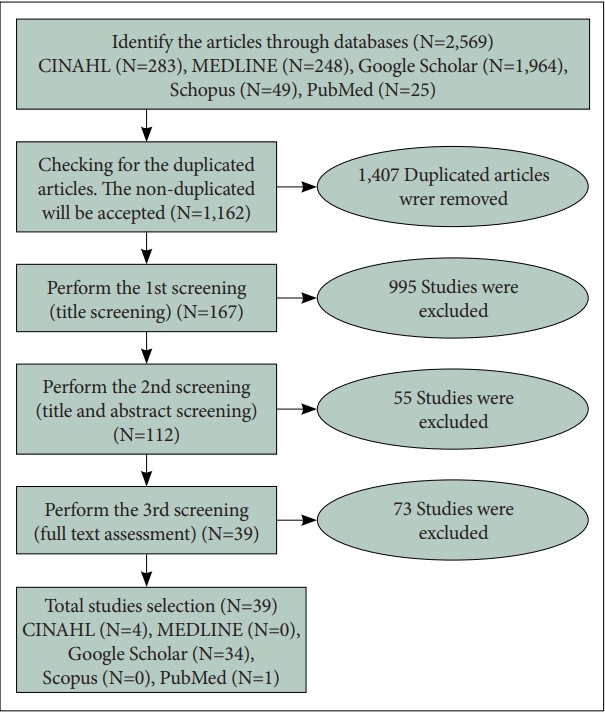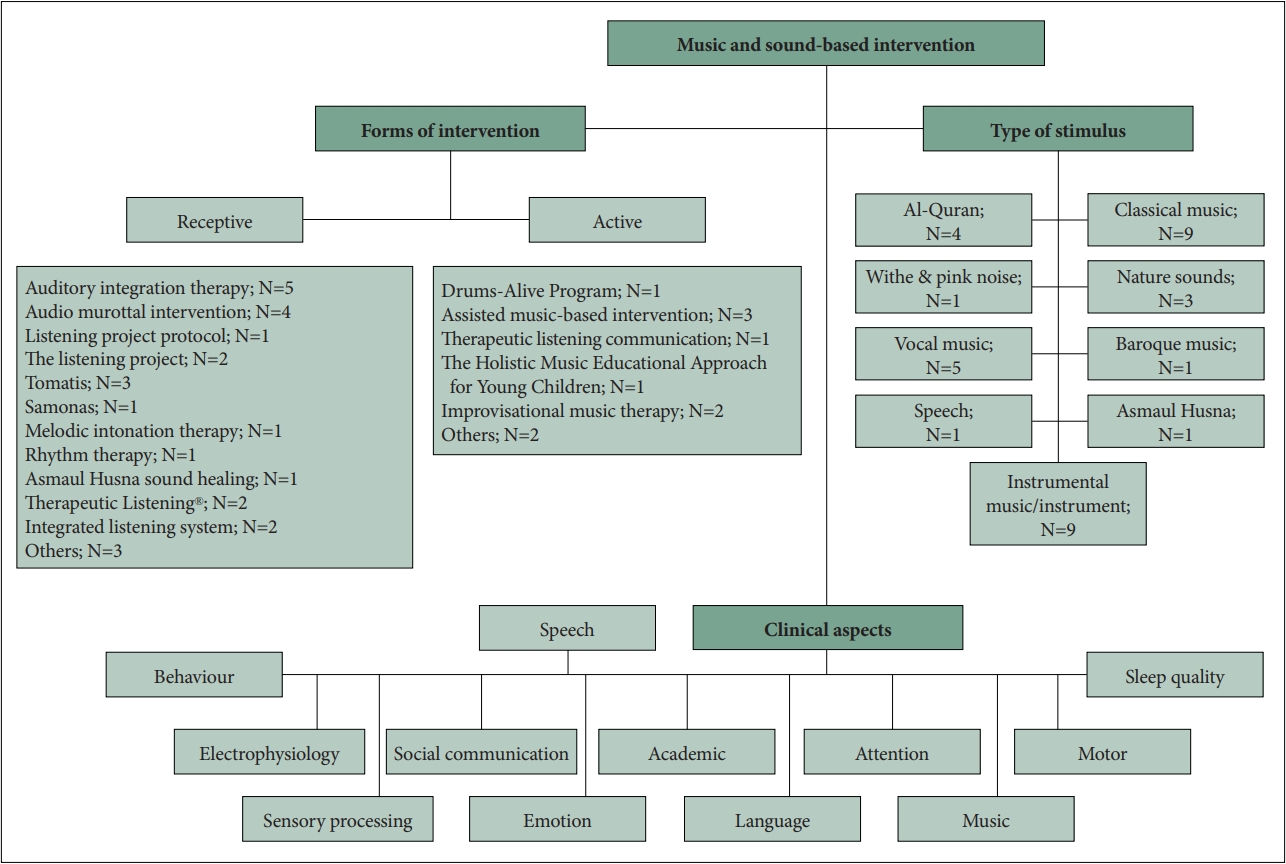1. Dobie RA, Van Hemel S, National Research Council. Basics of sound, the ear, and hearing. In: Dobie RA, Van Hemel S, National Research Council, editor. Hearing loss: determining eligibility for social security benefits. Washington, DC: National Academies Press, 2004, p. 42-68.
3. Cripe FF. Rock music as therapy for children with attention deficit disorder: an exploratory study. J Music Ther 1986;23:30-37.

4. Scott TJ. The use of music to reduce hyperactivity in children. Am J Orthopsychiatry 1970;40:677-680.


5. Goldstein C. Music and creative arts therapy for an autistic child. J Music Ther 1964;1:135-138.

6. Salim D. Psikologi musik. Yogyakarta: Galang Pres; 2009.
7. Sharma SR, Gonda X, Tarazi FI. Autism spectrum disorder: classification, diagnosis and therapy. Pharmacol Ther 2018;190:91-104.


10. Carpente JA. Investigating the effectiveness of a developmental, individual difference, relationship-based (DIR) improvisational music therapy program on social communication for children with autism spectrum disorder. Music Ther Perspect 2017;35:160-174.

11. Sani RF. Islamic guidance and counseling with Asmaul Husna sound healing to overcome temper tantrums for autistic children in SLB Tumbuh Kembang Ceria Bekasi [Master’s Thesis] Jawa Timur, UIN Sunan Ampel Surabaya. 2019.
12. Edelson SM, Rimland B. The efficacy of auditory integration training: summaries and critiques of 28 reports. San Diego: Autism Research Institute; 2008.
13. Link HM. Auditory integration training (AIT): sound therapy? Case studies of three boys with autism who received AIT. Br J Learn Disabil 1997;25:106-110.

14. Portalska H, Portalski M. Selected aspects of the use of digital signal processing in the sound therapy. In: Proceedings of the NTAV/SPA 2008: New Trends in Audio and Video/Signal Processing Algorithms, Architectures, Arrangements, and Applications; 2008 Sep 25-27; Poznan, Poland. IEEE. 2008;55-60.
18. Garness J, Giving B, Heidebrink T, Hein A, Humbert R, Janorschke E, et al. Auditory integration interventions for children with autism and developmental disabilities: an evidence-based practice project [Master’s Thesis] Saint Paul, St. Catherine University. 2016.
20. Villasenor RF, Smith SL, Jewell VD. A systematic review of sound-based intervention programs to improve participation in education for children with sensory processing and integration challenges. J Occup Ther Sch Early Interv 2018;11:172-191.

22. Peters MDJ, Godfrey C, McInerney P, Munn Z, Tricco A, Khalil H. Chapter 11: scoping reviews (2020 version). Australia: JBI; 2020, p. 406-451.
23. Sinha Y, Silove N, Wheeler D, Williams K. Auditory integration training and other sound therapies for autism spectrum disorders. Cochrane Database Syst Rev 2004;1:CD003681

24. Brbić I, Tomić L. An integrative review of the effectiveness of the tomatis method in children with autism spectrum disorder. RAD CASA - Medical Sciences 2020;543:49-56.
26. AbediKoupaei M, Poushaneh K, Mohammadi AZ, Siampour N. Sound therapy: an experimental study with autistic children. Procedia Soc Behav Sci 2013;84:626-630.

27. Al-Ayadhi LY, Majeed Al-Drees A, Al-Arfaj AM. Effectiveness of auditory integration therapy in autism spectrum disorders--prospective study. Autism Insights 2013;5:13-20.
28. Cibrian FL, Mercado J, Escobedo L, Tentori M. A step towards identifying the sound preferences of children with autism. In: In Proceedings of the 12th EAI International Conference on Pervasive Computing Technologies for Healthcare; 2018 May 21-24; New York, NY, USA. Association for Computing Machinery. 2018;158-167.

29. Sikström S, Söderlund G. Stimulus-dependent dopamine release in attention-deficit/hyperactivity disorder. Psychol Rev 2007;114:1047-1075.


30. Jamal FN, Dzulkarnain AAA, Shahrudin FA, Rahmat S, Ahmad Basri N, Sidek SNi, et al. Suppression Distortion Product Otoacoustic Emission (Suppression DPOAE) using Various Contralateral Suppressors among Autism Spectrum Disorder Children. In: In: International Evoked Response Audiometry Study Group Biennial Symposium; 2021 June 14-July 9; Virtual.
31. Kaf WA, Danesh AA. Distortion-product otoacoustic emissions and contralateral suppression findings in children with Asperger’s syndrome. Int J Pediatr Otorhinolaryngol 2013;77:947-954.


33. Neysmith-Roy JM. The Tomatis method with severely autistic boys: individual case studies of behavioral changes. S Afr J Psychol 2001;31:19-28.


34. Pitkola SM. Effectiveness of SAMONAS sound therapy (SST) in improving social engagement of children with autism spectrum disorder [Master’s Thesis] Melbourne, University of Melbourne. 2016.
35. Zhukova MA, Talantseva OI, Logvinenko TI, Titova OS, Grigorenko EL. Complementary and alternative treatments for autism spectrum disorders: a review for parents and clinicians. Clin Psychol Spec Educ 2020;9:142-173.


36. Roth N. Efficacy of musical interventions on social, maladaptive and language outcomes in children with autism spectrum disorder, a systematic review and meta-analysis [Master’s Thesis] Montréal, Université de Montréal. 2020.
38. McGowan JJ. Real-time 3D graphic augmentation of therapeutic music sessions for people on the autism spectrum [Master’s Thesis] Edinburgh, Edinburgh Napier University. 2019.
39. Edelson SM, Arin D, Bauman M, Lukas SE, Rudy JH, Sholar M, et al. Auditory integration training: a double-blind study of behavioral and electrophysiological effects in people with autism. Focus Autism Other Dev Disabil 1999;14:73-81.
40. Shahab M, Taheri A, Mokhtari M, Shariati A, Heidari R, Meghdari A, et al. Utilizing social virtual reality robot (V2R) for music education to children with high-functioning autism. Educ Inf Technol 2022;27:819-843.















